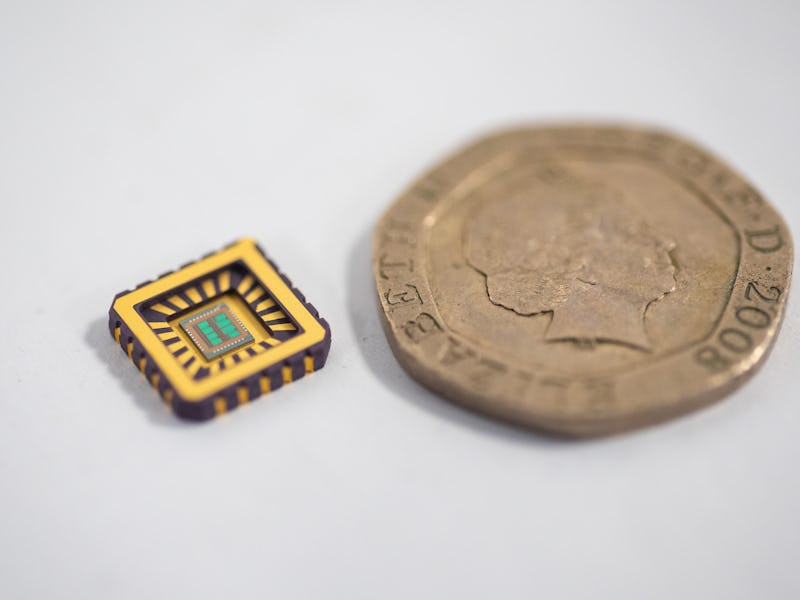Tiny artificial neuron could lead the fight against chronic brain diseases
Neuron decay is behind neuron decay in Alzheimer, seizures, spinal cord injury, and others. This chip could help.

A small, artificial chip could help repair a patient’s biological circuits and restore otherwise-lost functions.
Researchers at the University of Bath created a microcircuit, pictured above, which responds similarly to the body’s neurons. The findings were published in the journal Nature Communications this week. Alain Nogaret, one of the authors, tells Inverse that it could help with serious diseases.
“Our most immediate focus with these synthetic neurons, is to have the possibility to replace the function of neurons lost to chronic disease,” Nogaret says. “For example neurons at the base of the brain play an important role in preventing the onset of heart failure. When these fail, substituting them with artificial neurons can reverse heart failure. Other important needs for repairing biocircuits include neuron decay in Alzheimer, seizures, spinal cord injury.”
As researchers race to understand more of the brain and related circuitry, the team’s breakthrough could help patients with serious medical conditions — all with a chip smaller than a coin.
The chip next to a 20p piece.
The team designed a circuit that modeled ion channels. These are receptors that take chemical or mechanical input and turn them into electrical signals. They then worked to recreate the sort of activity seen in the neurons found in the hippocampal or respiratory systems.
The results were positive. The solid-state neurons resulted in nearly the exact same responses in a series of 60 stimulation protocols.
The brain has become a fascinating area of research, as more teams seek to augment its capabilities and add in human-built hardware. One team looking at invasive surgery is Elon Musk’s Neuralink, which hopes to put its chip in patients by the end of next year. The first trials will focus on patients with quadriplegia due to C1-C4 spinal cord injury. The N1 chip can enable its user to control a smartphone with just their brain.
The team is clear, however, that they’re not currently focused on writing brains up to machines.
“Brain-computer interfaces are not something we are actively considering right now as our priority is to focus on actual healthy and diseased cells,” Nogaret says. “The techniques we have developed could be extended to build models of hypothetical neurons, such as those needed to interface the brain, as Neuralink aims to do. However a better understanding of that interface would probably be needed as well as ethical considerations.”
For now, Nogaret points to how models of brain circuits could help with future research. Understanding how brain functions work, for example, could provide more insight into the effects of drugs on their electrical properties.
As for the chip itself, the team hopes that their initial research could lead to biological chips used to repair systems. In the case of the respiratory system, for example, the neurons are used to pair respiratory rhythms with cardiac rhythms. The failure to couple could lead to issues like heart failure. A future device could pair these rhythms together again, avoiding any further problems.
Prof Alain Nogaret and Dr Kamal Abu-Hassan in their lab.
It may be smaller than a coin, but the team’s chip could open up a new era of treatments for diseases.
>Abstract:
Bioelectronic medicine is driving the need for neuromorphic microcircuits that integrate raw nervous stimuli and respond identically to biological neurons. However, designing such cir- cuits remains a challenge. Here we estimate the parameters of highly nonlinear conductance models and derive the ab initio equations of intracellular currents and membrane voltages embodied in analog solid-state electronics. By configuring individual ion channels of solid- state neurons with parameters estimated from large-scale assimilation of electrophysiological recordings, we successfully transfer the complete dynamics of hippocampal and respiratory neurons in silico. The solid-state neurons are found to respond nearly identically to biological neurons under stimulation by a wide range of current injection protocols. The optimization of nonlinear models demonstrates a powerful method for programming analog electronic cir- cuits. This approach offers a route for repairing diseased biocircuits and emulating their function with biomedical implants that can adapt to biofeedback.